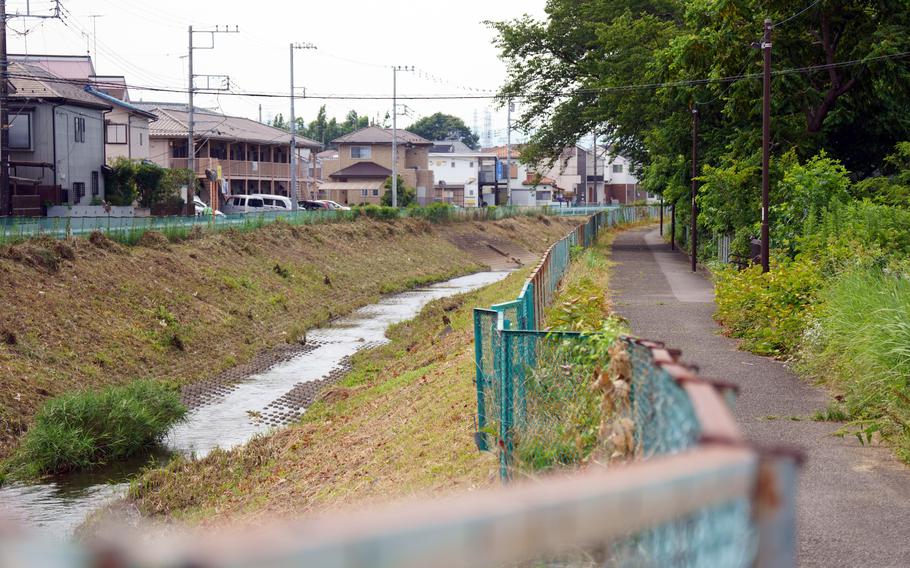
The Sakai River flows through Sagamihara, Japan, Monday, July 3, 2023. (Akifumi Ishikawa/Stars and Stripes)
TOKYO — High levels of toxic PFAS compounds — “forever chemicals” suspected of causing serious health issues — were recently detected in groundwater near a U.S. Army depot outside Japan’s capital, but the pollution’s source has yet to be determined.
A survey conducted between March and May by Kyoto University associate professor Koji Harada and Japanese newspaper Tokyo Shimbun examined two dozen spots in Kanagawa prefecture, just west of Tokyo, and found eight locations with concentrations exceeding Japan’s guidelines.
The two highest concentrations were found in drinking water at two apartment complexes, with levels six times higher than Japan’s provisional limit of 50 parts per trillion, Harada told Stars and Stripes by phone Monday.
“It doesn’t mean that there will be any immediate damage to health, but it’s not desirable to consume them in the long-term,” said Harada, an associate professor of health and environmental science who has conducted similar surveys in the past.
PFAS — per- and polyfluoroalkyl substances — are a group of manufactured chemicals commonly found in household products such as electronics, paint or water-repellent clothing, as well as fire extinguishing foam widely used at locations such as airports, factories and military bases, according to the Environmental Protection Agency.
A common characteristic of PFAS chemicals is that they “break down very slowly and can build up in people, animals and the environment over time,” according to the EPA, and current research shows high levels of exposure can lead to fertility issues, developmental effects, increased risks of cancers and other health concerns.
Though he would not identify the two apartment complexes, Harada said they were in Sagamihara’s Chuo ward, just a stone’s throw from the U.S. Army’s Sagami General Depot, home to the 38th Defense Artillery Brigade.
However, Harada clarified that the Army depot was not necessarily the source of PFAS in this instance and said more testing is necessary.
Several nearby factories had manufactured products containing the chemicals in the past, he said, but the survey was unable to gather enough information about those products or when they were produced.
A spokesperson for U.S. Army Japan did not immediately respond to an emailed request for comment Wednesday.
The survey examined 24 locations in Sagamihara and one in Machida, a city that shares a north-south border with Sagamihara, with PFAS concentrations steadily declining with distance from Chuo ward.
Spots tested included rivers, springs and wells, with eight locations measuring between 55 and 301 parts per trillion, Harada said. Many of the remaining 17 locations measured between 30 to 40 parts per trillion, well under Japan’s 50 parts per trillion limit but significantly higher than the 1.9 parts per trillion measured in Machida.
Sagamihara has conducted similar surveys since 2021 and plans to continue testing later this year, a city official told Stars and Stripes by phone Monday. Those surveys also found high concentrations of PFAS in Chuo ward, with the highest concentration measuring 1,500 parts per trillion, according to the city’s website.
It’s customary in Japan for some government officials to speak to the media on condition of anonymity.
Japan in 2020 established its 50 parts per trillion standard, although the provisional guideline is not legally enforceable. U.S. Forces Japan, under Japan Environmental Governing Standards, has a limit of 50 parts per trillion on PFAS in drinking water but no established limit for wastewater.
Yokosuka Naval Base, 31 miles southeast of Sagami Depot, in November installed a series of water filters and phased out the use of fire extinguishing foam containing PFAS after several rounds of tests revealed high levels of the chemicals in the base’s wastewater.
Japan should consider whether its provisional limit is appropriate, Harada said, because other countries have much lower limits and the United States in March proposed a limit of 4 parts per trillion.
Harada, in a separate survey released last month, examined levels of PFAS in the blood of people living in western Tokyo, home to Yokota Air Base, and found more than half the participants had levels that posed significant health risks, he said.